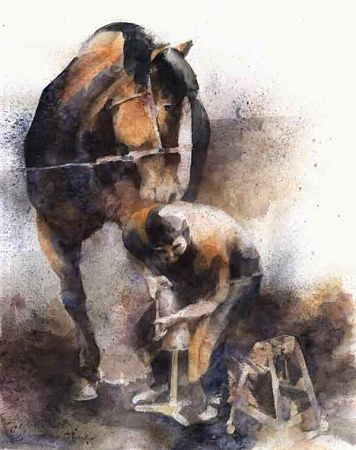I receive many calls every day about barefoot trimmers, farriers and people asking for recommendations in barefoot trimming or natural hoof trimming because they haven’t found the right trimmer or farrier and they want to do their own trimming.
When I saw this article written by Christa Leste-Lasserre, I thought it was excellent and would like to pass it on. It gives a very good prospective as to the difference in farriers. The following are excerpts from her article:
Choice of farrier might have a significant influence not only on the shape of a horse’s hoof, but its soundness and athletic ability, according to research carried out by veterinarians in Switzerland.
Forty dressage and show jumping horses, divided into six groups, were trimmed (and shod) by one of six selected farriers over a period of one year. Their hooves were periodically evaluated and compared by radiographic exam. Of 15 variable parameters evaluated, 14 differed significantly among farriers, according to an article based on the study and forthcoming in the Veterinary Journal. Parameters included dorsal wall length, hoof angle, sole thickness, the distance from the cannon bone to the toe and wall and other lengths and angles measured from front to side views.
Although all the parameters can affect the hoof’s shape, toe length and mediolaterial (side to side) hoof balance are most important for the horse’s overall soundness, said Martin Kummer, DVM, Dipl. ECVS, chief assistant in the Quine Hospital at the University of Zurich and primary author of the study. “The length of toe influences the point of break-over, (and) the mediolateral hoof balance could influence the loading pattern of the joint surfaces,” he noted. Farriers should take advantage of using “landmarks” for trimming the hoof such as the hoof-pastern axis, the center of articulation (widest part of the hoof) and trimming to the widest part of the frog.
When selecting a new farrier, Kummer suggested that owners have “good conversations” with prospects and talk with some of the potential farrier’s other clients before making a selection.
During Dr. Tomas Teskey’s Hoof Clinic, he spoke of farriers and trimmers that can sometimes get over-zealous and take way too much of the hoof. He strongly suggested that “less is better” in barefoot trimming or natural hoof trimming to eliminate horse hoof problems.
There are wonderful barefoot trimmers out there; however, Dr. Kummer is correct. Have “good conversations” with them before leaving your horse in their care. In addition, Dr. Teskey says that we, as horse owners, should be constantly educating ourselves so that we can have “good conversations.”

When you do have a horse with problems or to prevent hoof problems, use EasyCare protective horse boots and pads.
Dee Hoime

Customer Service
When you call EasyCare, I’m one of the folks that will answer. I’m also one of the cowgirls in the group. (Heck no, I don’t show, I Rodeo!) When it comes to life’s adventures – never pull back on the reins, and remember: the world is best-viewed through the ears of a horse!




